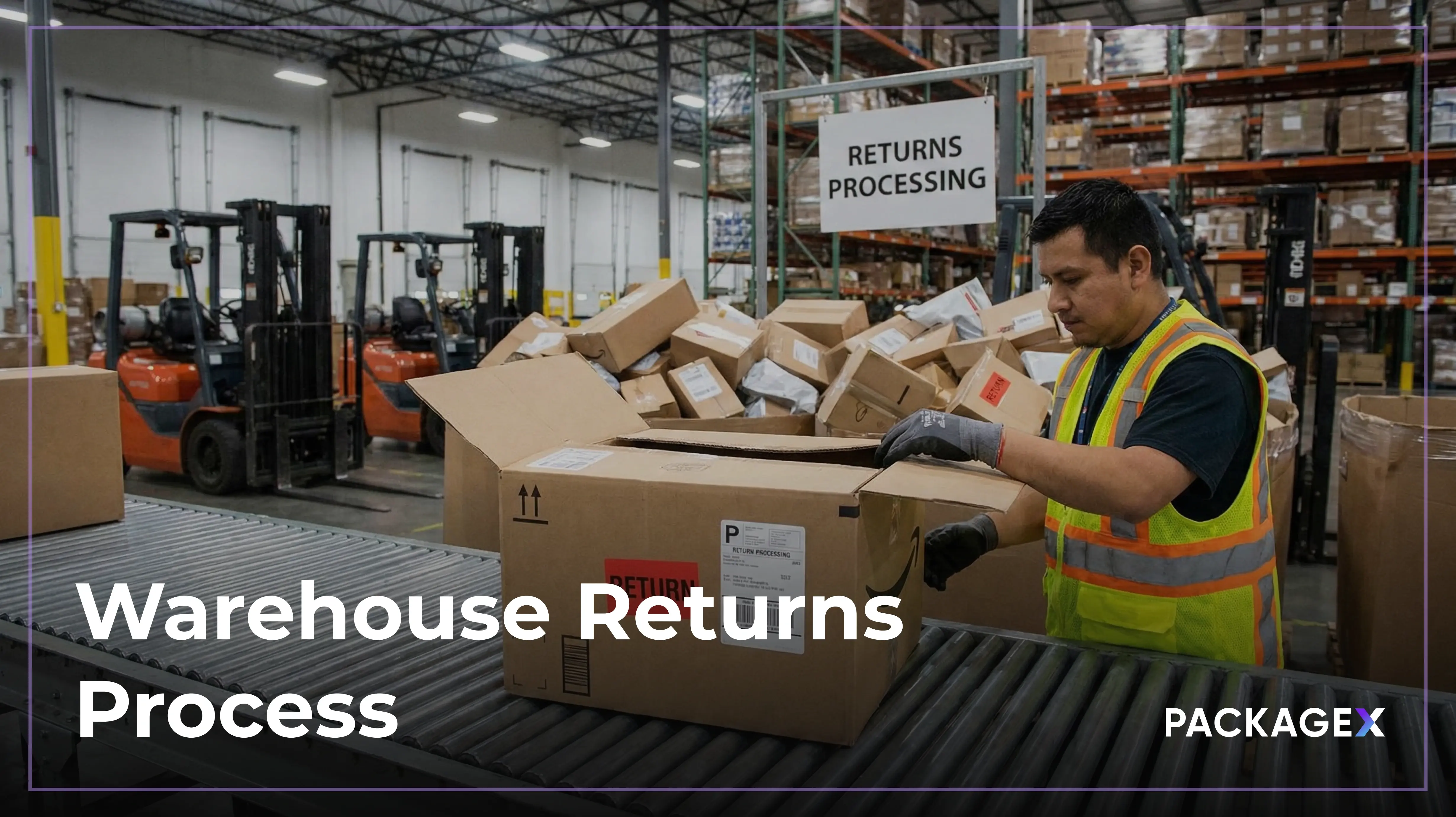In the current business landscape, efficient warehouse management can make or break a company’s success. From e-commerce giants to small retailers, managing inventory, order fulfillment, and shipping with precision is essential for maintaining profitability and meeting customer expectations. Despite the clear benefits, 80% of warehouses are still manually operated with no supporting automation—a sign that many businesses have yet to fully embrace warehouse automation.
But with so many types of warehouse management systems available, how do you know which one is right for your business? In this blog, we’ll explore four different types of WMS—each tailored to specific business needs, budgets, and operational complexities. Whether you're looking for a standalone solution, an integrated system, or a cloud-based platform, understanding the pros and cons of each type will help you make an informed decision that drives growth and efficiency.
What is a Warehouse Management System (WMS)?
A warehouse management system (WMS) is a set of policies and processes intended to organize the work of a warehouse or distribution center, and ensure that such a facility can operate efficiently and meet its objectives. The most important features of a Warehouse Management System (WMS) include:
- Inventory Tracking
- Order Management
- Picking and Packing
- Receiving and putaway
- Shipping
- Returns Management
- Labor Management
- Reporting and Analytics
- Barcode Scanning
- Integration Capabilities
The Benefits of Implementing a WMS
Implementing a WMS means having 24/7 real-time visibility of what is happening in your warehouse. With this you can see into the whole entire inventory, including in the warehouse and in transit. Other than full visibility, there are three other benefits to cover:
Improved accuracy
Accuracy is the foundation of efficient warehouse and supply chain management. When these systems work in harmony, goods are stored and handled with precision, minimizing waste, reducing costs, and boosting overall operational performance.
Warehouse management systems know exactly where each item is located and the current stock levels before initiating a picking wave, ensuring that orders are fulfilled correctly the first time. With less reliance on manual processes, businesses not only reduce costly mistakes but also improve their ability to meet customer demands with consistency and precision.
Reduced waste costs
In a previous post, The Most Costly but Overlooked Part of Reverse Logistics, we shared that automation can efficiently determine what items must be recycled or resorted, enabling proper disposal and material reuse standards. For example, if you manage perishable or time-sensitive inventory, a WMS can prioritize which items should be picked first and alert you to those that may need a sales boost to avoid waste.
Enhanced customer satisfaction
A WMS improves inventory accuracy, reducing the likelihood of errors such as stockouts or incorrect shipments. This leads to faster order processing and more reliable deliveries, ensuring customers receive their products on time and as expected. Additionally, real-time inventory tracking allows businesses to provide up-to-date information to customers, fostering transparency and trust. With greater efficiency and fewer mistakes, organizations can deliver a better overall experience, which boosts customer loyalty and satisfaction.
4 Types of Warehouse Management Systems
Standalone Warehouse Management Systems
Standalone WMS are specialized software systems focused exclusively on managing warehouse operations. They are designed to handle tasks like inventory tracking, order picking, and shipping without requiring integration with broader business systems. These solutions are typically chosen by companies that need a powerful and dedicated warehouse management tool, offering flexibility and advanced features tailored to warehouse-specific needs, without the complexity of integrating with other business processes.
Pros and Cons:
Pros: High degree of customization, warehouse-specific features, optimized for deep functionality, robust tools focused solely on improving warehouse efficiency.
Cons: Lack of integration with other enterprise systems, which may necessitate using additional software for broader supply chain management. This could result in siloed data or inefficiencies in coordinating with other departments.
Cloud-Based WMS
A cloud-based WMS is hosted on remote servers and accessed via the internet, making it an increasingly popular choice due to its scalability and flexibility. Businesses can access their WMS from any location with an internet connection, and the software is usually updated automatically by the provider. Cloud-based solutions allow companies to avoid the upfront costs and maintenance of on-premise systems, making them ideal for businesses of all sizes, especially those expecting growth.
Pros and Cons:
Pros: Lower initial investment since there’s no need for expensive hardware, high scalability to accommodate business growth, remote access for greater flexibility, automatic updates handled by the provider, which reduces IT overhead.
Cons: Dependence on reliable internet access, ongoing subscription fees instead of a one-time cost, potential concerns over data security and privacy when using third-party cloud providers.
Supply Chain Execution Modules (SCE)
Supply Chain Execution (SCE) modules are part of a larger supply chain management suite that includes a variety of functions such as transportation management, order management, and warehouse management. SCE provides businesses with a holistic view of their supply chain operations, enabling better coordination and execution across all aspects of supply chain management. By integrating these modules, companies can achieve end-to-end supply chain visibility and efficiency.
Pros and Cons:
Pros: Offers an integrated approach to managing the entire supply chain, providing better alignment between warehousing, transportation, and order fulfillment. SCE modules streamline operations, reduce redundancies, and enhance real-time decision-making by providing end-to-end visibility of the supply chain.
Cons: Implementation can be complex and may require significant customization to fit a company’s unique processes. The cost of deploying SCE modules, particularly as part of a broader suite, can also be high, especially for smaller businesses.
ERP-Integrated WMS
ERP-integrated WMS is embedded within an Enterprise Resource Planning (ERP) system, allowing companies to manage warehouse operations alongside other critical business functions such as accounting, HR, and customer relationship management. This unified platform creates a centralized hub for business processes, ensuring consistency and easier coordination across departments.
Pros and Cons:
Pros: Centralized data management allows for consistency across business processes, reducing the risk of data silos. Since the WMS is part of the ERP system, integration with other modules like finance or human resources is seamless, making it easier to track and align warehouse operations with broader business objectives.
Cons: These systems may not offer the same level of specialized features and flexibility as standalone WMS solutions. Additionally, ERP systems tend to be more expensive to implement and maintain, which can be a significant investment for companies.
Log Warehouse Activity Automatically With Any WMS
There are over a hundred WMS options to choose from but getting data into all of them is hard. And with hundreds of packages being delivered monthly, weekly, or even daily, having an easier way to manage this volume of deliveries should be easier. Luckily, with PackageX, you can connect warehouse activity to your receiving, inventory, and fulfillment operations to support fast-moving logistics.
Our warehouse management software can optimize several warehouse operations like inventory management, pick and pack order fulfillment, receiving, storing, and shipping. As a result, you can enhance efficiency, productivity, and visibility in your warehouse logistics operations.
PackageX improves warehouse inventory accuracy through its integrated apps and APIs that modernize your whole warehouse management software (WMS). Our inventory app offers real-time visibility for inventory tracking and accurately matches inbound shipments or packages to your ordered list. You can also track items and quantities at an item level without any errors.
Four Breakthroughs with PackageX
Analog to Digital
Maybe you have a WMS and rely on manual data entry. With PackageX, you can digitize and log warehouse activity automatically.
Hidden to Visible
When warehouse activity is digitized, it becomes visible in real time. This makes internal operations more efficient and gives customers better insight into what’s happening with their shipment.
Siloed to Connected
WMS software and legacy systems of record lead to stale data, redundant work, and siloed warehouse operations. PackageX connects everything with software that supports “systems of engagement”.
Slower to Faster
Warehouses that function as logistics nodes must operate at the speed of logistics. This means more efficient receiving, stocking, and shipping. PackageX enables all of this.
{{returns-webinar}}
Conclusion
Choosing the right Warehouse Management System (WMS) is a critical decision for businesses of all sizes, as it directly impacts operational efficiency, inventory management, and customer satisfaction. Whether you opt for a standalone WMS for focused functionality, a cloud-based system for flexibility, or an ERP-integrated solution for seamless business operations, the key is to align the system with your specific business needs and goals.
By understanding the pros and cons of different types of WMS, you can select a system that not only improves accuracy and reduces waste but also enhances overall customer satisfaction. As warehouse management continues to evolve, investing in the right WMS will help your business stay competitive, adaptable, and efficient.
Ready to take your warehouse management to the next level? Discover how PackageX’s innovative solutions can optimize your operations and drive growth. Request a demo to learn more about PackageX and our solutions.
FAQs
1. What is the difference between standalone and integrated WMS?
Standalone WMS is a specialized software that focuses solely on managing warehouse operations. It offers robust features specifically designed for inventory management, order processing, and warehouse efficiency. The primary advantage of a standalone WMS is its deep functionality and customization tailored specifically to warehouse management.
Integrated WMS, on the other hand, is part of a broader system like an ERP (Enterprise Resource Planning) or SCM (Supply Chain Management) platform. Integrated WMS provides a seamless connection between warehouse operations and other business processes, such as procurement, sales, and finance. The main benefit of an integrated WMS is the unified data flow across different departments, leading to better coordination and streamlined operations. However, it may not offer the same depth of warehouse-specific features as a standalone WMS.
2. Can small businesses benefit from using a WMS?
Yes, small businesses can significantly benefit from using a WMS. Even though a WMS is often associated with large enterprises, small businesses can leverage its features to enhance accuracy, reduce manual errors, and optimize inventory management. A cloud-based WMS is particularly advantageous for small businesses because it offers scalability, lower upfront costs, and ease of use without the need for significant IT infrastructure. By implementing a WMS, small businesses can improve order fulfillment speed, maintain better inventory control, and ultimately provide better customer service, which is crucial for growth and competitiveness.
3. How does cloud-based WMS ensure data security?
Cloud-based WMS providers typically implement a range of security measures to protect data. These include:
- Data Encryption: Data is encrypted both in transit and at rest, ensuring that sensitive information is protected from unauthorized access.
- Regular Security Audits: Cloud service providers conduct regular security audits and vulnerability assessments to identify and address potential threats.
- Multi-Factor Authentication (MFA): MFA adds an extra layer of security by requiring users to provide two or more verification factors to access the system.
- Compliance with Industry Standards: Many cloud-based WMS solutions comply with industry standards and regulations, such as GDPR or ISO 27001, ensuring that they follow best practices for data protection.
Backup and Recovery: Regular data backups and disaster recovery plans ensure that data can be quickly restored in case of any breach or system failure.




